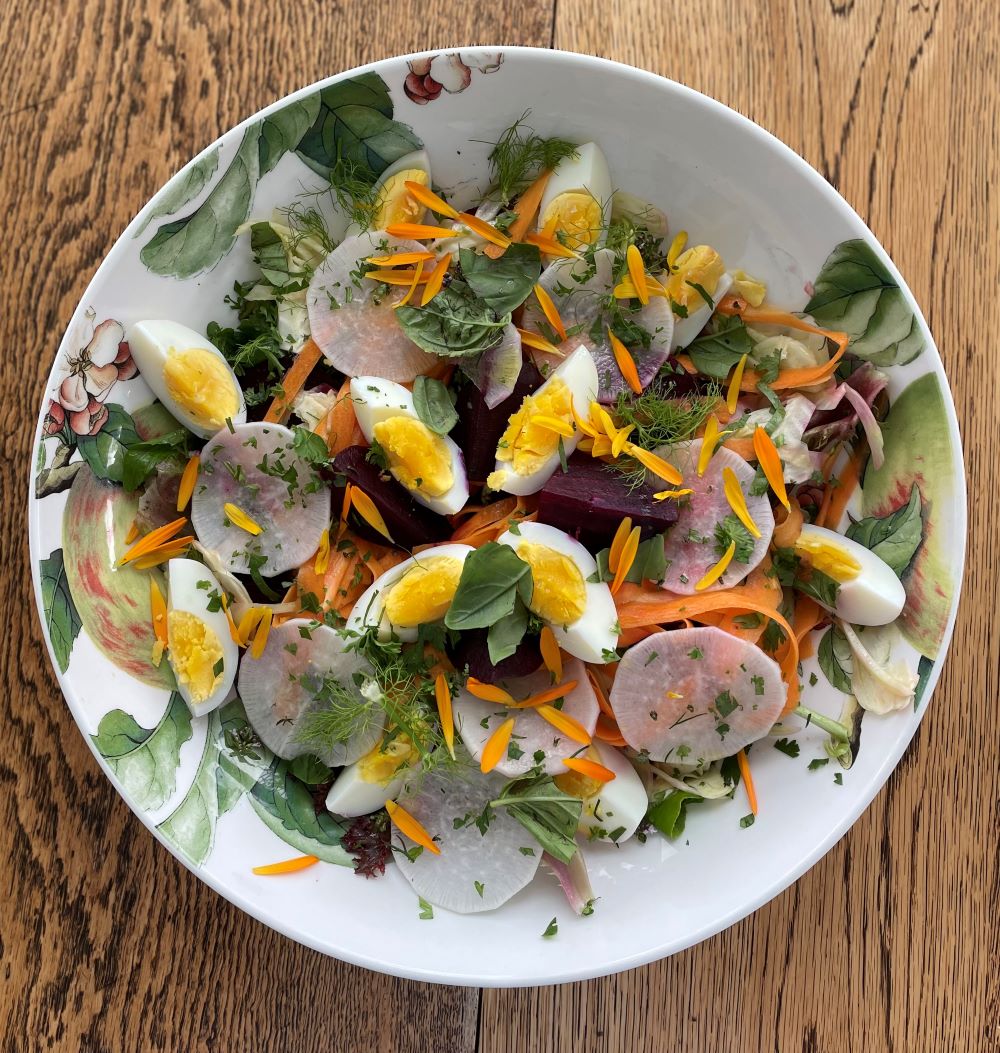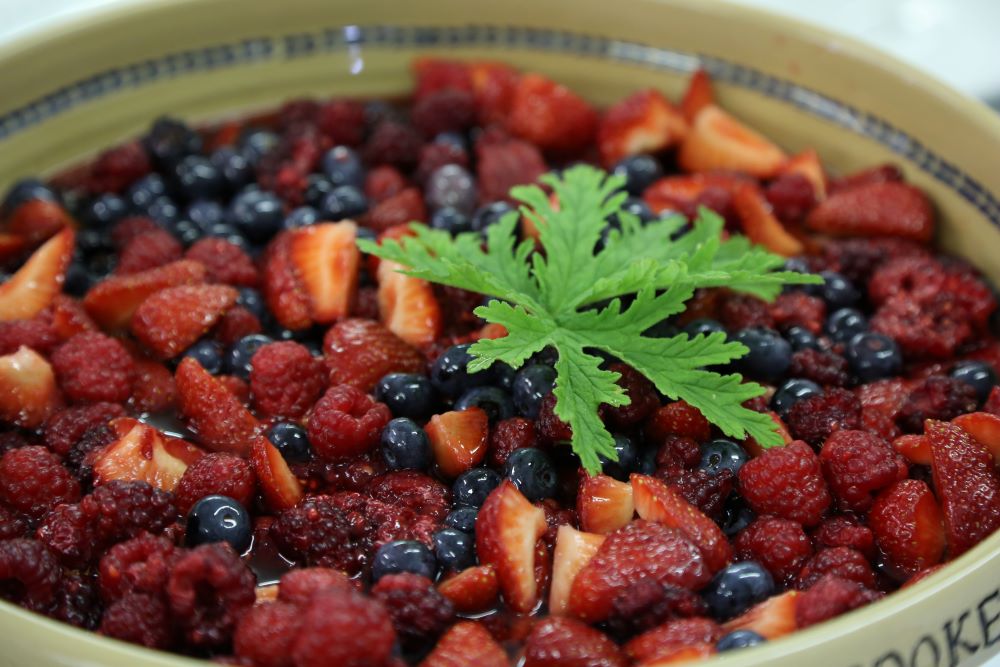The Darina Allen Column - Change and Innovation
From very intensive conventional farmers to organic and biodynamic, even some small holders with just a couple of acres, to landowners with 6000 plus acre estates. All had a common purpose, at the Groundswell Regenerative Agricultural Festival.
 I've recently returned from the hugely inspirational Groundswell Regenerative Agricultural Festival in the UK. This was my second attempt to get to the event, which is held on Lanark Manor Farm near Weston in Hertfordshire. Last year I got as far as London, but a train strike prevented me from getting to the festival. Since the initial Groundswell eight years ago, there has been an explosion of interest in regenerative farming and food systems change. Originally 400 farmers gathered in The Barn to share ideas in an open minded and positive setting. This year over 5,000 turned up to explore regenerative solutions that subsequent generations will thank us for. It was a broad church, from very intensive conventional farmers to organic and biodynamic, even some small holders with just a couple of acres, to landowners with 6000 plus acre estates - all with a common purpose ...
I've recently returned from the hugely inspirational Groundswell Regenerative Agricultural Festival in the UK. This was my second attempt to get to the event, which is held on Lanark Manor Farm near Weston in Hertfordshire. Last year I got as far as London, but a train strike prevented me from getting to the festival. Since the initial Groundswell eight years ago, there has been an explosion of interest in regenerative farming and food systems change. Originally 400 farmers gathered in The Barn to share ideas in an open minded and positive setting. This year over 5,000 turned up to explore regenerative solutions that subsequent generations will thank us for. It was a broad church, from very intensive conventional farmers to organic and biodynamic, even some small holders with just a couple of acres, to landowners with 6000 plus acre estates - all with a common purpose ...
It was a packed programme, with over 200 speakers including Joel Williams, Nicole Masters, Zach Bush, Anne Bilké, Richards Perkins... Often, inevitably, two talks that I desperately wanted to hear were running concurrently, but most were recorded and will be available on Groundswell's YouTube channel, so you too can listen to many of the presentations. Gatherings like this stimulate mindset change and innovation at this challenging time.
If you're one of the happy gardeners who planted a few packets of seeds in Spring to grow some of your own food, you're probably overwhelmed with an abundance of beautiful chemical-free produce at present.
There are not ever enough meal slots to enjoy all the fresh vegetables. Tomatoes and cucumbers in the greenhouse; beets and courgettes; the first of the French beans; chillies, floury potatoes, tons of salad leaves and voluptuous basil to make pesto and to toss into salads and pasta dishes. So much work has gone into growing that I can't bear to waste a scrap, but everything seems to peak together, quite the challenge...
%20.jpg) We enjoy super ripe loganberries and tayberries from the aptly named Currant and Berry Garden...such a treat. After enjoying a simple little feast with a dollop of Jersey cream and a sprinkling of caster sugar, I make the remaining berries into jam – such fun and super easy. The recipe works brilliantly for raspberries too and, even though I've been making jam since I was a child, I still relish the glow of satisfaction as I line up the jars of my very own homemade jam on the shelves in the pantry, I always think of them as good deeds to admire.
We enjoy super ripe loganberries and tayberries from the aptly named Currant and Berry Garden...such a treat. After enjoying a simple little feast with a dollop of Jersey cream and a sprinkling of caster sugar, I make the remaining berries into jam – such fun and super easy. The recipe works brilliantly for raspberries too and, even though I've been making jam since I was a child, I still relish the glow of satisfaction as I line up the jars of my very own homemade jam on the shelves in the pantry, I always think of them as good deeds to admire.
By coincidence, a copy of 'The Greens Cookbook', arrived in the post this week. A Grub Street reprint of Deborah Madison's original book that created a revolution in cooking when it first appeared over 35 years ago, it’s now regarded as a classic - and here in this handsome new edition are the recipes that helped to create the boldly original and highly successful Greens Restaurant on San Francisco Bay where I vividly remember eating in the 1980s. Available from good bookshops or online, €35.
Here are a few recipe suggestions…
 SUMMER GARDEN SALAD
SUMMER GARDEN SALAD
Some salads are tossed, while others, like this one given to me by my good friend David Tanis. are composed. Feel free to improvise here: A few spinach leaves, watercress, a handful of raw sweet garden peas or fava beans, asparagus or thinly sliced raw artichoke can be nice additions. For a true celebration of summer, make sure to gather an assortment of complementary leaves, herbs and vegetables, and arrange them artfully.
Serves 4
For the Vinaigrette
1 small shallot, finely diced
salt and black pepper
50ml lemon juice plus 1 tsp zest
2 tsp Dijon mustard
5 tbsp extra-virgin olive oil
For the Salad
3 medium red or gold beets, cooked and cut into wedges (see Tip)
salt and black pepper
ribbons of peeled carrots
4 handfuls salad greens, preferably a mix of arugula and lettuce, such as Little Gem or Red Oak
5cm piece daikon radish, or 1 medium watermelon radish, peeled and very thinly sliced
1 bunch small radishes or baby turnips, trimmed and halved
1 medium fennel bulb, cored and thinly sliced
4 eggs, boiled for 7-8 minutes, then cooled, peeled and halved
50g fresh mixed herbs, such as sprigs of tarragon, basil, mint, dill or chervil
Nasturtium or Calendula blossoms, for serving (optional)
Make the vinaigrette: Put the shallot in a small bowl, and add a pinch of salt, the lemon juice, zest, and mustard. Whisk until the salt dissolves, then whisk in the olive oil. Taste, and add more salt and pepper to taste.
Prepare the salad: Put beet wedges in a small bowl, season with salt and pepper, and toss with 1 ½ tablespoons vinaigrette. Set aside.
Put the salad leaves in a large mixing bowl, salt very lightly and dress with ¾ tablespoon vinaigrette. Divide among individual plates or arrange on a platter. Scatter the beets, carrot ribbons, radishes and fennel over the leaves. Arrange the egg halves over the top. Season the eggs with salt and pepper.
Top with the herbs and blossoms, if using. Drizzle the remaining vinaigrette over the salad and serve.
TIP - To cook beets, place in a roasting pan with 2.5cm of water, tightly cover with foil and bake at 190°C/Gas Mark 5 until tender, about 1 hour. Once cool enough to handle but still warm, slip the skins off the beets. Peeled beets will keep refrigerated for up to a week.

Sweet geranium (Pelargonium Graveolens) and many other varieties of scented geraniums are ever present on our windowsills here at Ballymaloe. We use the delicious lemon scented leaves in all sorts of ways, occasionally we use the pretty purple flowers also to enliven and add magic to otherwise simple dishes. The crystallised leaves, all frosty and crinkly, are wonderful with fresh cream cheese and fat juicy blackberries.
I discovered this recipe, which has now become a perennial favourite, quite by accident a few summers ago as I raced to make a pudding in a hurry with the ingredients I had at that moment.
Serves 8-10
110g raspberries
110g loganberries
110g redcurrants
110g blackcurrants
110g small Strawberries
110g blueberries
110g fraises du bois or wild strawberries
110g blackberries
Syrup
325g sugar
450ml water
6-8 large sweet geranium leaves
Put all the freshly picked berries into a white china or glass bowl. Put the sugar, water and sweet geranium leaves into a stainless steel saucepan and bring slowly to the boil, stirring until the sugar dissolves. Boil for just 2 minutes. Cool for 4-5 minutes then pour the hot syrup over the fruit and allow to macerate for several hours. Remove the geranium leaves. Serve chilled, with softly whipped cream or vanilla ice-cream or on its own. Garnish with a few fresh sweet geranium leaves.
SUMMER BERRY JELLY WITH SWEET GERANIUM LEAVES & SWEET GERANIUM CREAM
Sometimes when we have a berry salad leftover, particularly if there is more juice than fruit, we make it into a jelly. Use 4 teaspoons of gelatine to each 600ml of liquid. You'll need 1.2 litres for a large ring mould. Turn it out carefully onto a large white china plate when it is set, fill the centre with softly whipped cream and decorate with geranium leaves.
RASPBERRY, TAYBERRY OR LOGANBERRY JAM
Raspberry jam is the easiest and quickest of all jams to make, and one of the most delicious. Loganberries, Boysenberries or Tayberries may also be used in this recipe.
Makes 3 x 450g pots
900g fresh raspberries, tayberries or loganberries or a mixture
790g granulated sugar
Wash, dry and sterilise the jars in the oven 100°C/Gas Mark ¼, for 15 minutes.
Heat the sugar in a moderate oven 180°C/Gas Mark 4 for 5-10 minutes.
Put the raspberries into a wide stainless steel saucepan and cook for 3-4 minutes until the juice begins to run, then add the hot sugar and stir over a gentle heat until fully dissolved. Increase the heat and boil steadily for about 5 minutes, stirring frequently.
Test for a set by putting about a teaspoon of jam on a cold plate, leaving it for a few minutes in a cool place. It should wrinkle when pressed with a finger. [Note: If the jam overcooks, it will be too thick - just add a little boiling water to loosen].
Remove from the heat immediately. Skim and pour into sterilised jam jars. Cover immediately.
Hide the jam in a cool place or else put it on a shelf in your kitchen so you can feel great every time you look at it! Anyway, it will be so delicious it won't last long!
HOT TIPS
Fancy starting a coffee shop?
Foundations of a Coffee Shop Course by Tracie Daly at Waterman House Cookery School, Belfast. Join Tracie Daly (Ballymaloe Cookery School alumni) and Niall McKenna at Waterman House Cookery School in Belfast to improve your culinary skills and to maximise profit in your proposed or current business setup. The course takes place on Wednesday, 20th September 2023. For details visit www.traciedaly.com
http://www.cookingisfun.ie/





There are currently no comments
Leave a comment
Not a member? Register for your free membership now!
Or leave a comment by logging in with: